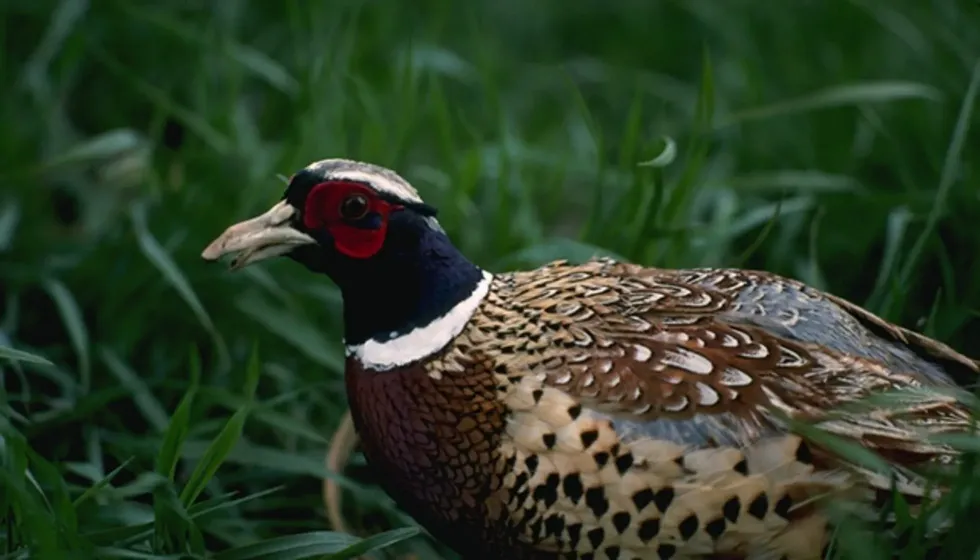The common pheasant is also known by the name ring-necked pheasant. This name is given to this subspecies of the common pheasant with white neck rings. Ring-necked pheasant is also the name given to the species as a whole in North America.
Ring-necked pheasants are birds of the family Phasianidae and the genus Phasianus. The species was earlier part of the genus Gallus, containing junglefowl and domestic chickens.
This pheasant is distributed across the range in Asia and some parts of Europe. However, these pheasants have been introduced to many different places as a game bird. These birds have become quite popular as game birds and are found throughout the world.
Male ring-necked pheasant birds have copper and gold plumage with a crisp white ring. The female bird, or hen, is mostly brown in color to easily blend into its habitat.
The green subspecies from Japan have an iridescent emerald body, pale aqua-colored rump, and shoulder. Cold temperatures in the winter season are not a problem for these pheasants and these birds are known to choose their breeding ground at the onset of the spring season. This bird species has a diet of seeds and grains mostly.
However, they also feed on insects. Predators of this bird species include foxes, coyotes, and raccoons.
Habitats like croplands and agricultural landscapes are very important for ring-necked pheasants. However, rigorous farming practices in their range have reduced the population of these North American birds drastically. Most of the prime pheasant habitats in the range have been destroyed.
The grassy areas that the birds most desperately need are now gone. However, the population all over the world is still intact and there is no immediate danger to the species currently. This is the reason for fewer conservation measures for the birds.
For more relatable content, check out these facts about the koklass pheasant and golden pheasant.
Ring-Necked Pheasant Interesting Facts
What type of animal is a ring-necked pheasant?
A common pheasant or ring-necked pheasant is a pheasant found in Eurasia with white neck rings. As there are no relatives to these species of birds in Europe, these birds are simply known as pheasants. However, the name ring-necked pheasant is given to the population of these North American birds.
What class of animal does a ring-necked pheasant belong to?
The ring-necked pheasant (Phasianus colchicus) falls under the class of Aves in the kingdom of Animalia. It is part of the family Phasianidae.
How many ring-necked pheasants are there in the world?
The worldwide population range is said to be between 160,000,000-219,999,999 individuals currently. Apart from the usual range of habitat, these pheasants have also been introduced as a game bird species in many parts of the world. The conservation status is Least Concern at the moment.
Where does a ring-necked pheasant live?
Ring-necked pheasants are native to Asia and some parts of Europe. The bird is non-migratory.
The native range of common pheasants or ring-necked pheasants is from the Caspian Sea to the east from central Asia to China. The bird is also found naturally in Korea, Japan, and former Burma. These pheasants are now introduced to many different countries as a game bird species.
These places are Europe, North America, New Zealand, Australia, and Hawaii. In the North American range, these pheasants are seen in southern Canada, Utah, the New England states, California, and Virginia.
What is a ring-necked pheasant's habitat?
The primary habitat range of this bird includes farms, fields, marsh edges, and brush. These birds are found occupying farmlands and grasslands.
With the preference for open cover, the habitat of the ring-necked pheasant bird includes stubble and grass fields. The habitat must include grass, ditches, hedges, marshes, and tree stands or bushes for the birds to use as cover. These pheasants are not found in areas of dense rainforest, alpine forests, and very dry places.
The birds do not prefer open waters, however, most of the population is found near waters. The pheasants can also be observed near overgrown or recently harvested fields, rural roadsides, and in brushy areas and hedgerows.
Proper cover of shrubs and dense grasses in the winter season can help the bird species live through the cold.
Agricultural practices like removal of bushes, burning of marshes, monoculture, and commercial establishments are destroying the only habitat of this species in the wild, and conservation of the land is now required.
Who do ring-necked pheasants live with?
Pheasants are known to live in flocks in all the habitats with their own group. Before the onset of winter, flocks of these pheasants are seen flying together and searching for food.
Ring-necked pheasants are social birds and a large group is often seen in fall. The home ground range in the nesting season is bigger than the winter season. The nesting season is usually in spring and the flocks in the winter months can be mixed-breed.
In spring, these groups disperse with males leaving first.
How long does a ring-necked pheasant live?
The survival of the chicks is depending on the hatching time, body mass, and the habitat the bird is residing in. The survival rate of the ring-necked pheasant female annually is 21-46 %, while for males it is only 7 %.
In the wild, these pheasants are known to survive for no more than three years. In captivity, the average age can go up to 18 years. The lower age in the wild is due to the lack of any conservation measures for these birds.
The young have a high mortality rate.
How do they reproduce?
Male birds are known to establish a crowing ground near protective cover. Nesting ground is chosen in the early spring season by the males.
These pheasants mostly stay in the ground and roost on the ground or at the bottom of trees. The breeding season is in the early spring months of mid-March to early June. A male is sometimes found with a flock of females in the breeding season.
This group stays together throughout the breeding process and the nest-making period. A group usually contains between two to 18 females with just one male.
The preparation of the nest begins just before the females start laying the eggs. The nest is made by the female on the ground by scrapping a shallow hole in a well-covered region.
The nest is then lined with plant materials. Females are peculiar and lay a single egg a day in the nest. This process is repeated until five to 15 eggs are laid in the nest.
The average number of eggs is 10-12. Sometimes more than a single hen lay eggs in the same nest during the breeding period.
Male ring-necked pheasants are not very active during this period while the females tend to the nest and the young. The young after hatching are covered fully in down.
The young mature fast and are able to walk with the female hen right after birth. In 12 days, they are able to fly and in 70-80 days, they become fully independent. The incubation time is around 23 days after the last egg of the year is laid.
What is their conservation status?
The conservation status of the ring-necked pheasant is categorized as Least Concern by the IUCN Red List. Various farming practices in their habitats along with commercial establishments have degraded the habitat. Also, these birds get killed by predators.
Ring-Necked Pheasant Fun Facts
What do ring-necked pheasants look like?
Male pheasants are bright colored with a golden body, a red face, and a distinctive white ring in the iridescent green neck. The tail is very long and is coppery with thin black colored bars on it. Females however are different with a brown body.
They have a pale scaling on the upper parts of the body. The underside is buff or cinnamon-colored and there are black spots on the sides. The tail has thin, black bars.
The subspecies found in North America can have variations in colorations.
How cute are they?
They are very beautiful with a darker, mottled body and a pretty white collar on the greenish-blue head. They are also very conscious about the beauty they possess and are often seen taking care of their old feathers with sand.
How do they communicate?
The ring-necked pheasant call can be heard throughout the forest. The rooster-like crowing is quite loud and this is a noisy bird.
How big is a ring-necked pheasant ?
The length of these pheasants is between 19.7-27.6 in (50-70 cm). The wingspan is 22.1-33.9 in (56-86 cm).
The argus pheasant is 63-79 in (160-200 cm) long with a tail length of 41-56 in (104-142.2 cm).
How fast can a ring-necked pheasant fly?
They mostly stay grounded and are known to be swift runners. They are also strong flyers with speeds going up to 27-38 mph (43.4-61.1 kph) while cruising. This can change when being chased as the maximum speed is seen up to 56 mph (90.1 kph).
How much does a ring-necked pheasant weigh?
The weight of this bird is between 1.1-6.6 lb (499-2993.7 g).
What are the male and female names of the species?
Males and females of these birds can be called cocks and hens, respectively.
What would you call a baby ring-necked pheasant ?
Babies are called chicks or young.
What do they eat?
Ring-necked pheasants feed mostly on grains, seeds, shoots, berries, insects, and small invertebrates.
These pheasants are also known to feed on insects like grasshoppers, caterpillars, crickets, ants, beetles, snails, and earthworms.
Are they dangerous?
They are not considered dangerous.
Would they make a good pet?
They are mainly kept as game birds. Females are sometimes kept as pets for their eggs.
Did you know...
These birds are known to used taller vegetations in wild habitats for cover on the ground. They can fly at good speeds.
They are non-migratory and native to Eurasia. However, they have been introduced to other regions too.
The main diet of this bird is seeds and grains.
Are ring-necked pheasants invasive?
The ring-necked pheasant is often found harassing ground-nesting birds like the greater prairie chicken and the gray partridge. They can be considered to be invasive.
What does a ring necked pheasant sound like?
This is a very noisy bird. The male makes a crowning call which sounds like a loud, piercing, double squawk 'ko-ork kok'. This sound is made in the dusk, dawn, and during the mating period. The sound can travel up to 1 mi (1.6 km). The call from females is subtle and rarely heard.
Here at Kidadl, we have carefully created lots of interesting family-friendly animal facts for everyone to discover! For more relatable content, check out these carrion crow facts and Hawaiian honeycreeper facts for kids.
You can even occupy yourself at home by coloring in one of our free printable Ring necked pheasant coloring pages.










